Types of Yard Mushrooms (With Pictures): Identification Guide
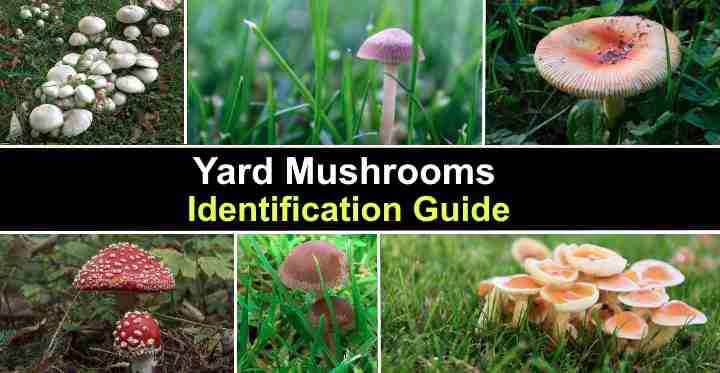
Mushrooms growing in the front or backyard are a common sight. The mushrooms can appear almost instantly in lawns and gardens after a rainy period or in areas with high humidity. Knowing how to identify common yard mushrooms is crucial. Some mushrooms growing in the yard are harmless, whereas others can be toxic and harmful if ingested.
This article is an identification guide to different types of mushrooms commonly found in yards.
How to Identify Mushrooms in the Yard
Mushroom identification is possible by carefully examining key features like cap shape, color, texture, gills, or pores underneath, and stalk shape and color. Additionally, some mushrooms have distinctive odors that help identify the species. You can also tell some types of yard mushrooms by where they are growing.
For example, many types of mushrooms typically grow in lawns. However, you may also come across mushrooms growing on trees, under bushes, or in dark, moist areas of your front or backyard.
Most mushrooms grow during spring, summer, and fall. However, fall is typically the prime mushroom season when you will likely see the fungal growths sprout up in your yard. This time of year, warm weather and damp conditions provide the ideal environment for mushrooms to thrive.
Potential Dangers of Common Yard Mushrooms
Common species of yard mushrooms often include toxic fungi that resemble edible ones. Therefore, you must be extremely careful when picking mushrooms. Ingesting toxic varieties of mushrooms can lead to severe illness or even death due to liver failure, kidney damage, gastrointestinal distress, and neurological symptoms.
Even mushroom experts (mycologists) sometimes have difficulty telling an edible mushroom apart from a toxic variety. Many edible mushrooms have toxic look-alikes, making accurate identification essential. And making a mistake when eating mushrooms can have fatal consequences.
This article is a general guide to help identify common yard mushrooms. However, it does not give advice on identifying edible yard mushrooms for consumption. Therefore, never eat any type of mushroom found in your yard without identifying the mushroom type with 100 percent certainty.
Why Are Mushrooms Growing in the Backyard?
You can find mushrooms growing in your yard for several reasons. Mushrooms are sponge-like fruiting bodies that thrive on decaying organic matter, warm temperatures, and high humidity. Yard mushrooms are often a sign of a healthy ecosystem. The spongy growths also feed on decaying organic matter, allowing nutrients to get into the soil and grass.
Related reading: How to get rid of mushrooms in the lawn.
Types of Mushrooms in the Yard
Let’s look in detail at common varieties of mushrooms that grow in your yard.
Ringless Honey Mushroom (Desarmillaria caespitosa)

Ringless honey mushrooms are common in backyards and typically grow in clusters at the base of trees, stumps, or decaying wood. Appearing in the fall, the parasitic mushrooms are known for their honey-colored convex caps and whitish gills. Unlike other honey mushrooms, the ringless honey mushroom lacks a distinct ring (annulus) on the stem.
Ringless honey-colored mushrooms grow 2” to 8” (5 – 20 cm) tall with a flattened cap and a slightly wavy margin. The honey mushroom caps grow 0.80” to 4.0” (2 – 10 cm) in diameter. Apart from their honey color, they also have a sweet, honey-like aroma.
Yard mushroom identification
The ringless honey mushroom is a distinctive yellow-brown to honey-brown fungus with creamy-white gills and tapering stalks.
Meadow Mushroom (Agaricus campestris)

Meadow mushrooms are common edible whitish mushrooms found in backyards and lawn areas. The white mushroom is identified by its white cap and pinkish gills that turn brown. The mushroom’s cap is smooth and bell-shaped and grows 1.5” to 4.5” (4 – 11 cm) in diameter. It has a white, ringless stem.
Meadow mushrooms are classified as edible mushrooms. However, you must be careful because they have toxic look-alikes such as the fool’s mushroom (Amanita verna), death cap (Amanita phalloides), and false meadow mushroom (Agaricus semotus).
Meadow mushrooms are typically found in front or backyards in late summer to early fall. They are useful yard fungi because they break down decaying organic matter in the soil, helping improve the soil’s nutrient content.
Yard mushroom identification
Meadow mushrooms can be identified by their white cap, pinkish gills, and white, ringless stem. They also have a smooth and bell-shaped cap, and the white mushrooms grow 1.5” to 1.75” (4 – 4.5 cm) tall.
Haymaker Mushroom (Panaeolus foenisecii)
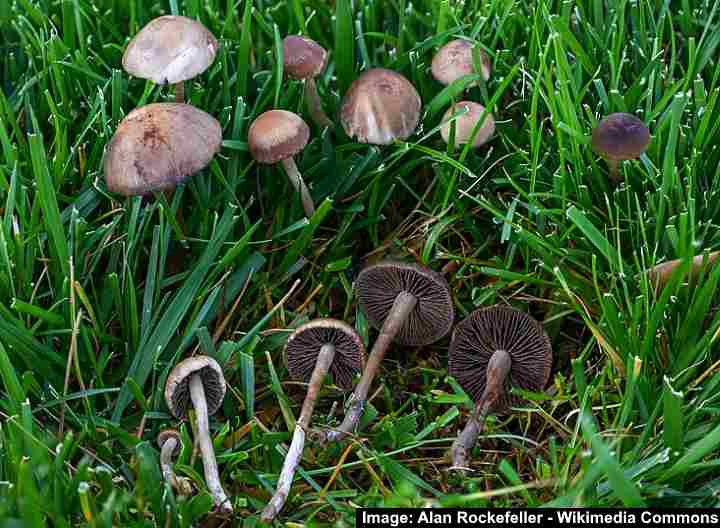
Also called the mower’s mushroom, this fruiting body is a common garden mushroom. The small brown mushroom appears in lawns in summer and fall. Identifying features of the haymaker mushroom are its pale buff to dark brown bell-shaped cap, chocolate-brown gills, and slender stems 2.3” to 4” (6 – 10 cm) long.
Haymaker mushrooms are common lawn mushrooms, often sprouting after rain or in humid conditions from late spring through fall. The slender brown mushrooms are inedible but emit a nutty odor.
Yard mushroom identification
Haymaker mushrooms are slender brown fungi with a pale buff to dark brown bell-shaped cap and dark brown gills. The brown stipes (stalks) sometimes become whitish nearer the gills.
Common Stinkhorn (Phallus impudicus)
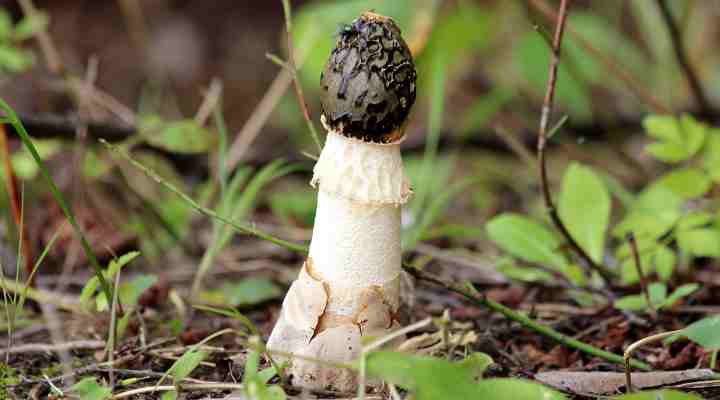
The common stinkhorn looks like a phallus and is a big white mushroom found in yards in North America. The fungi are known for their foul odor, resembling rotting flesh or sewage. The unusual mushroom has a tall, thick stalk and an egg-shaped dark cap covered in a slimy, sticky substance.
Common stinkhorn mushrooms are fast-growing fungi, sometimes growing 4” to 6” (10 – 15 cm) per hour. Older stinkhorns lose the slimy goo on their caps to reveal a yellowish pitted cap with ridges resembling morel mushrooms. In backyards, the common mushroom grows near rotting wood and grassy areas and can be found from summer to late fall.
Yard mushroom identification
The common stinkhorn features an erect, cylindrical structure with a conical cap covered in olive-brown, foul-smelling slime. This distinctive mushroom has a white stalk 2” (5 cm) in diameter and is 4” to 12” (10 – 30 cm) tall.
Lawyer’s Wig (Coprinus comatus)
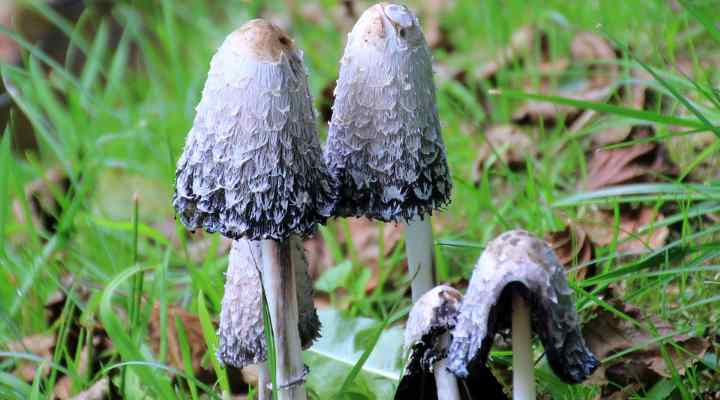
Lawyer’s wig is a common yard mushroom characterized by its distinctive white cylindrical cap covered in shaggy scales. The white mushroom grows up to 6” (15 cm) tall with a skinny stipe. It sometimes has a brown circle on the cap’s top.
Also called the shaggy ink cap, the easily identifiable feature is its oblong cap that flares at the base and is covered in curled scales. When mature, the cap starts to dissolve into a black, inky liquid, giving it its name. Lawyer’s wig mushrooms are typically found in fields, meadows, and grassy areas.
Yard mushroom identification
Lawyer’s wig is a common backyard mushroom characterized by its distinctive white oval, oblong cap covered in a shaggy mane. It looks like a white or gray fuzzy egg on top of a cylindrical stem.
Fly Agaric (Amanita muscaria)
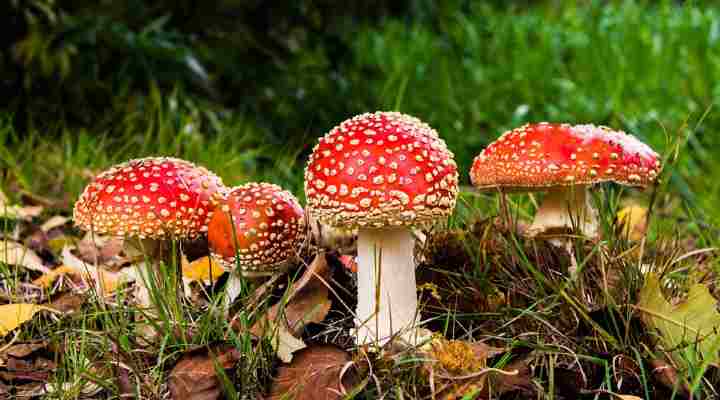
Fly agaric is an easily identifiable red and white mushroom found in yards and forests. This mushroom features a brightly colored red cap covered in white spots—the classic image of a toadstool. The disc-like red cap can grow up to 8” (20 cm) in diameter and has a distinct convex shape.
The fly agaric mushroom is a variety of highly toxic mushrooms that grow in shaded areas of yards. In addition to their red and white caps, the mushrooms are identified by their thick white stems and white gills underneath the bell-shaped cap. They are often found growing near birch and pine trees.
Yard mushroom identification
Fly agaric is a highly toxic mushroom species with a brightly colored red cap covered in white spots and a thick white stalk. It has a distinct convex shape that flattens to a large disc as it matures.
Fairy Ring Mushroom (Marasmius oreades)
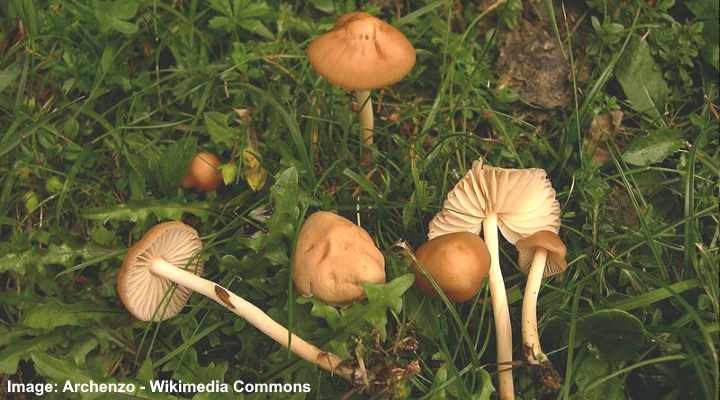
Fairy ring mushrooms are a common type of tan or brown yard mushroom often found growing in rings in lawns. The mushrooms have a pale brown bell-shaped cap, sometimes with an uplifted edge. Under the cap are creamy-white gills attached to a thin stem up to 2.5” (6 cm) tall.
Fairy ring mushroom convex caps are 0.5” to 2” (1.3 – 5 cm) in diameter. These types of lawn mushrooms have a distinct fragrance described as spicy or almond-like. The edible mushrooms have a sweet flavor. However, you must be careful because they have toxic look-alikes such as the Clitocybe dealbata and Clitocybe rivulosa mushrooms.
Yard mushroom identification
Fairy ring mushrooms are small, delicate fungi with a tan to light brown cap and a slender, fibrous stem. They often grow in circular formations, known as fairy rings, and can be found in grassy areas in front and backyards.
Giant Puffball (Calvatia gigantea)

The giant puffball is a unique and impressive yard mushroom. The large white round mushroom grows 4” to 20” (10 – 50 cm) in diameter. The largest species can weigh over 40 lbs. (20 kg). The puffball mushroom’s outer skin is white and smooth or slightly textured, while the inner flesh is soft and white, resembling a marshmallow.
Giant puffball fungi look like irregularly-shaped balls on grass. They are known for their rapid growth, with some specimens reportedly increasing in size by several inches overnight. Sometimes the huge white mushrooms can grow in fairy rings in lawns.
Yard mushroom identification
The giant puffball is a large, round mushroom that can grow up to one foot (30 cm) in diameter. It usually has smooth, white outer skin and a soft, spongy interior. When mature, it releases a cloud of spores when touched or stepped on.
Chicken Of The Woods (Laetiporus sulphureus)
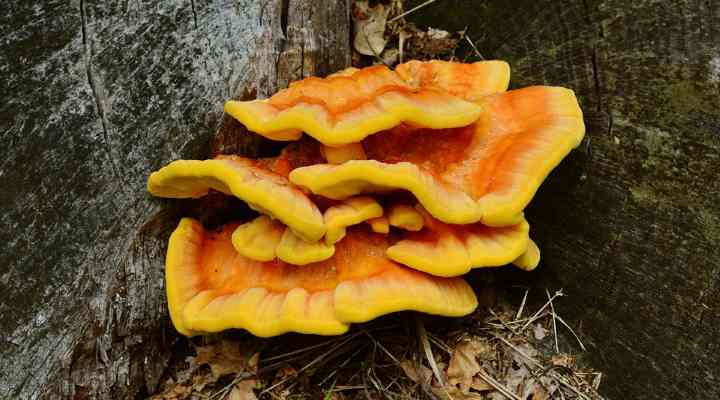
Chicken-of-the-woods is a common type of yellow or orange mushroom you may find growing on trees in your backyard. The orange fruiting bodies grow on beech, oak, chestnut, and other hardwood trees. It grows in large, overlapping clusters with fan-shaped or semicircular caps creating a shelf-like appearance.
Chicken-of-the-woods “shelves” can grow between 2” and 24” (5 – 61 cm) in diameter. The cap is bright orange or yellow-orange in color, often fading towards the edges. The flesh of the mushroom is thick and succulent.
Foragers search out this tree-growing mushroom for its chicken or lobster-like flavor and meaty texture. However, it is important to note that proper identification is crucial, as there are some toxic look-alikes.
Yard mushroom identification
Chicken-of-the-woods is an easily recognizable vibrant orange fungus that grows in shelf-like formations on tree trunks. It commonly grows up to 24” (61 cm), creating a large orange knobby mass on the host tree.
Beefsteak fungus (Fistulina hepatica)
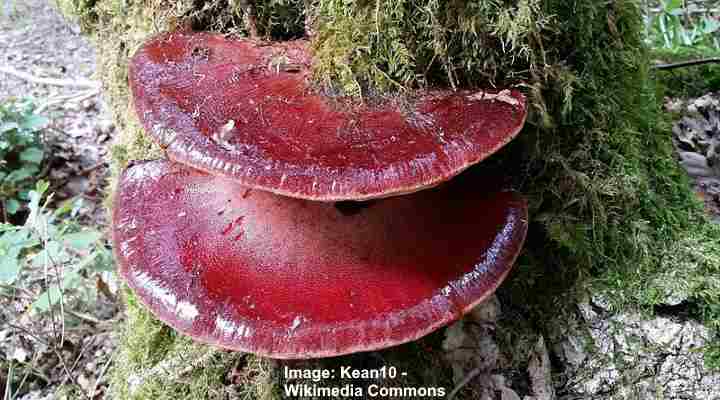
Beefsteak fungus is a large type of bracket mushroom commonly found growing on trees in yards and forests. Its name comes from its resemblance to a slab of raw meat—a large reddish-brown fruiting body that looks like a tongue. Its underside is bright yellow, making it easy to identify in backyards.
The flesh cap of the beefsteak fungus grows 2.7” to 12” (7 – 30 cm) in length and up to 2.4” (6 cm) wide. The cap’s surface is often wrinkled with a slightly sticky texture. The flesh of the mushroom is firm and has a meaty texture, hence the name.
Yard mushroom identification
The beefsteak fungus is a large reddish-brown with a fleshy thick cap that is attached to deciduous tree trunks..
White Dapperling Lawn Mushroom (Leucoagaricus leucothites)
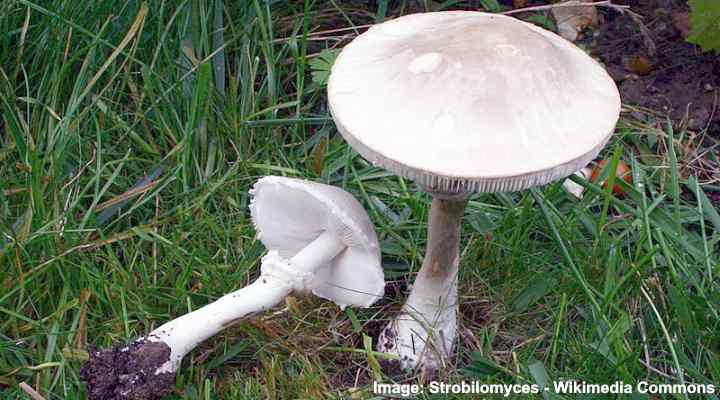
The white dapperling lawn mushroom is a common fruiting body growing in front or backyard lawns and grassy areas. Identifying features of the white mushroom are a smooth, bell-shaped cap, long stipe with an enlarged base, and ring on its stem. The white dapperling lawn mushroom grows 2” to 5” (5 – 13 cm) tall.
Also called the white Agaricus mushroom, the yard mushroom has a cap 1.5” to 6” (4 – 15 cm) in diameter. This mushroom is considered edible; however, it has poisonous look-alikes, notably the deadly death angel (Amanita ocreata).
The white dapperling lawn mushroom can be found from late spring to early fall.
Yard mushroom identification
White dapperling lawn mushrooms are small, delicate fungi with a white cap, white gills, and a scaly ring on the stems. The mushrooms can be gray-brown or pinkish, making exact identification challenging.
Green-Spored Parasol (Chlorophyllum molybdites)
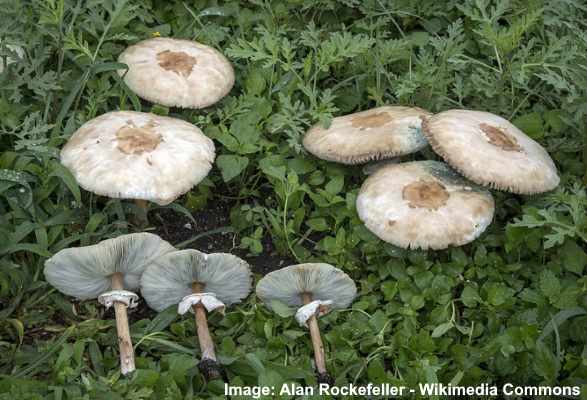
The green-spored parasol is a poisonous white fleshed mushroom commonly found in backyards and lawns. Its identifying features are its large, flattened umbrella-like cap, white gills that turn green with age, and a double-edged ring on the stem.
As the white mushroom matures, it develops a scaly cap with a pinkish-brown to brown center. The disc-like cap can grow 3.1” to 12” (8 to 30 cm) in diameter. This lawn mushroom grows in fairy rings in lawns throughout North America, and can reach 3.14” to 7.8” (8 – 20 cm) tall.
Yard mushroom identification
The green-spored parasol is a large toxic mushroom with a white or cream-colored cap up to 12” (30 cm) wide and a tall, slender stalk 2” to 12” (5 to 30 cm) tall.
Common Conecap Mushroom (Conocybe tenera)
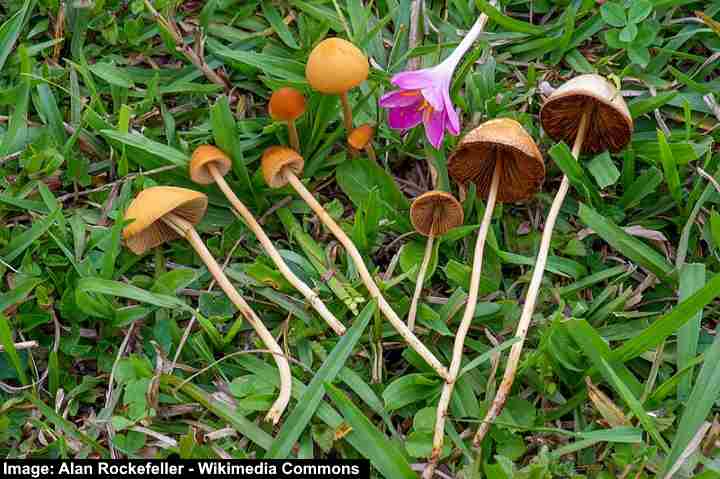
The common conecap mushroom is a small, dainty brown-orange mushroom found in yards and lawns. The small yard mushroom is identified by its conical or bell-shaped cap, brown gills, and slender, straight stems. The cap is typically 0.4” to 1.2” (1 – 3 cm) in diameter on top of a stipe 2” to 3.5” (5 – 9 cm) tall.
The common conecap mushroom is commonly found in grassy areas in North America. You will commonly find the small brown mushrooms from May through September, usually after rain or in humid conditions.
It’s important to note that the mushroom is a poisonous lawn mushroom and shouldn’t be consumed.
Yard mushroom identification
The common conecap mushroom is a small, delicate fungus with a pale brown to yellowish-brown cap and a slender, fragile stem. It has a conical or bell-shaped cap and grows in small groups.
Destroying Angel Mushroom (Amanita bisporigera)
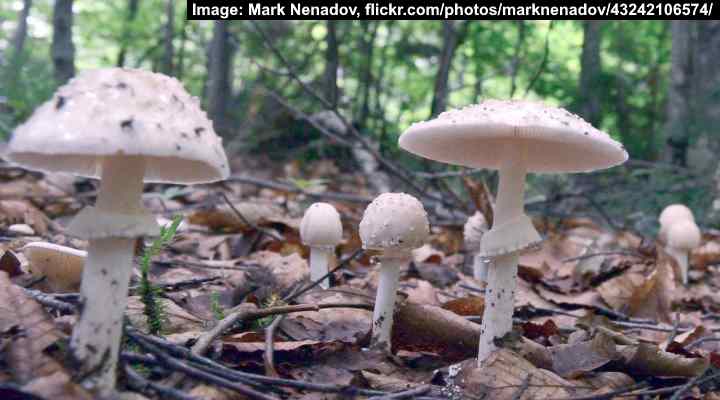
The destroying angel mushroom is a highly toxic white mushroom that can appear in shaded yards and wooded areas. The destroying angel mushroom has a smooth white or pale yellow cap, upright stipe with a white skirt-like ring, and bulbous base. The large poisonous mushroom can grow 5.5” (14 cm) tall.
The cap of the destroying angel mushroom grows 4” (10 cm) across. Underneath, it has white gills and a membranous cup-shaped base. The entire mushroom is covered in a thin, white veil when young, but this veil often disappears as the mushroom matures.
As its name suggests, the destroying angel mushroom is one of the most poisonous mushrooms in the world. It looks like other white mushrooms in the genus Amanita, which are just as deadly.
Yard mushroom identification
The destroying angel mushroom is identified by its white, smooth cap that can be flat or convex, robust white stalk with a skirt-like ring, and an enlarged base.
Scruffy Twiglet Mushroom (Tubaria furfuracea)

The small inedible orange-brown scruffy twiglet mushroom has a flat to convex cap with whitish patterns, an elongated slim stalk, and orange-brown gills. It grows 0.39” to 2” (1 – 5 cm) tall, and its cap is up to 1.57” (4 cm) wide.
This common yard mushroom can sometimes grow in large clusters in shaded areas of the yard under hardwood trees.
Yard Mushroom Identification
The orange-brown scruffy twiglet mushroom has a small, slightly rounded cap, thin stalk and a mild odor.
Common Morel (Morchella esculenta)
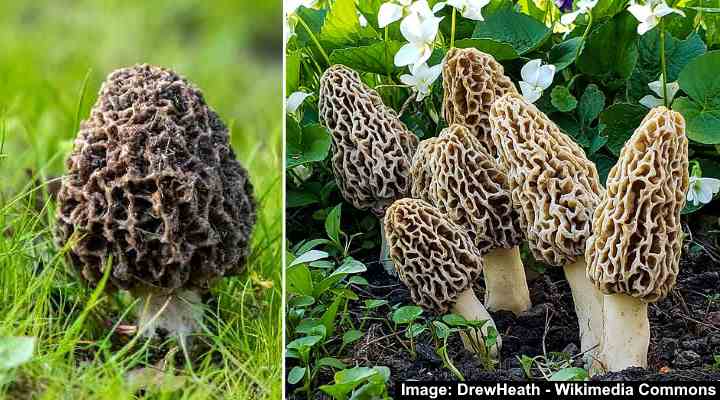
The common morel is one of the most unusual edible yard mushrooms because it looks like a large elongated walnut growing on a white stem. The pale, brownish-cream to gray-brown mushroom has a distinctive spongy appearance with an irregular oval cap attached to a short, stout stem.
The bumpy sponge-like cap of the common morel measures 0.78” to 2.7” (2 – 7 cm) in diameter, and its stem is 0.78” to 3.5” (2 – 9 cm) long.
These yard mushrooms typically grow in lawns and meadows and are usually found in spring. They have an intense meaty flavor with earthy overtones.
Yard Mushroom Identification
You can identify the common morel by its unique spongy appearance consisting of irregular ridges and holes.
Related articles:
- Red Mushrooms – Identification Guide
- Orange Mushrooms – Identification Guide
- Common Types of Yellow Mushrooms
